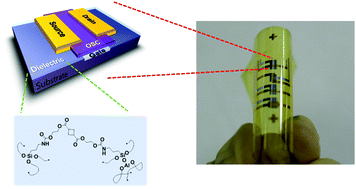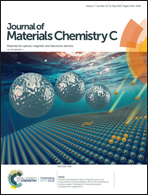Densely cross-linked polysiloxane dielectric for organic thin-film transistors with enhanced electrical stability†
Abstract
A solution-processable organic–inorganic hybrid material composed of a polysiloxane urethane acrylate composite (PSUAC) was developed through a dual cross-linking mechanism and satisfies all the requirements for use as a gate dielectric for flexible organic thin-film transistors (OTFTs). PSUACs incorporate the urethane group for promoting adhesion to substrates and the acrylate group for enhancing the degree of cross-linking via a photo-curing reaction. Aluminium acetoacetate is introduced as a thermal curing agent that reacts with the silanols at the end of the PSUA resin, thus realizing a reliable dielectric that is barely affected by the slow polarization induced by moisture absorption. Thin films of the cross-linked PSUAC provided smooth surfaces with a root-mean-square roughness of <0.3 nm and which exhibited high breakdown voltages of >6.2 MV cm−1, while the capacitance was only slightly affected by the frequency. A self-assembled monolayer (SAM) of octadecyltrichlorosilane (ODTS) was formed on the cross-linked PSUAC dielectric to provide a hydrophobic surface with a water-contact angle of 107°. OTFTs employing a small-molecule organic semiconductor of dibenzothiopheno[6,5-b:6′,5′-f]thieno[3,2-b]thiophene (DBTTT) were fabricated using the cross-linked PSUAC as a gate dielectric. These realized a high mobility of 3.3 cm2 V−1 s−1 and an on/off ratio of >107 without any hysteresis in the transfer characteristics. The threshold voltage was shifted by about 2 V in the bias stress measurement conducted for 10 000 s on non-passivated devices exposed in air, verifying the stable characteristics of the gate dielectric layer even without passivation of the device. Flexible OTFTs on a polyimide (PI) substrate were fabricated and identical electrical properties with a mobility of 3.3 cm2 V−1 s−1 were confirmed. PSUAC can be used as a reliable gate dielectric for high-performance OTFT devices including flexible applications.



 Please wait while we load your content...
Please wait while we load your content...